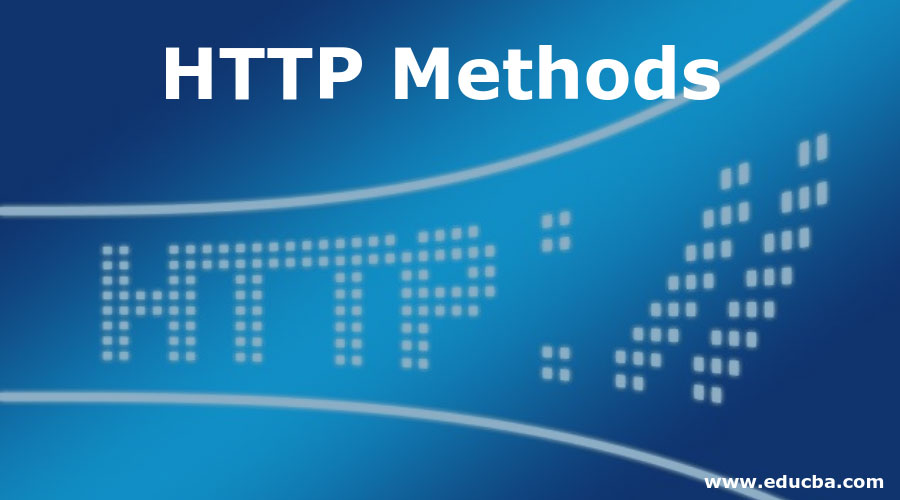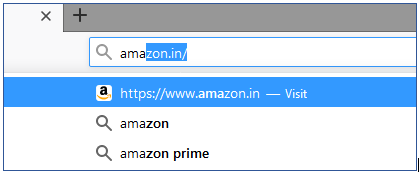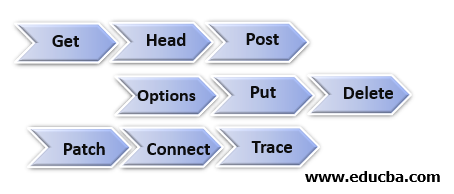What Is The Http Method That Retrieves Data By Uri?

Introduction to HTTP Methods
The following article outlines the methods of HTTP. Any activity is washed over the web, be it spider web browsing or online shopping, which is basically an substitution of data between the finish device and the spider web-server. We expect a secure connection betwixt our device and the spider web server hosting the site that protects the integrity and confidentiality of the data being exchanged. HTTP (Hypertext Transfer Protocol) is the universally agreed-upon format of transmitting data over a network that governs how data is exchanged between the user devices and website servers and what actions are taken past the web servers and browsers for each 'control'. HTTPS is an advanced and more secure upgrade to HTTP.
Example
- Browsing Amazon.

Equally nosotros start typing the discussion "Amazon" in the address bar or search bar, note here that the browser has automatically suggested the target web address equally "https://world wide web.amazon.in/".

As nosotros click enter and the website is loaded, we also come across the icon of a lock right before the spider web address indicating a secure connexion following HTTPS protocols. Any information transferred through HTTPS connection is encrypted earlier transmitting with Secure Sockets Layer (SSL) and Transport Layer Security (TLS) methods.
All this together ensure the post-obit iii layers of security

- Encryption: All data that is exchanged is encrypted.
- Data Integrity: No data tin be corrupted or modified during transit.
- Authentication: Ensures that users are continued with the intended websites.
HTTP Methods (Besides Chosen Verbs)
While browsing, the end-user (browser action) sends requests to the web server and the server sends the correlated response. HTTP defines a gear up of asking methods to indicate the chosen activity to be performed. Any user can apply any method and the server can be designed to back up whatever combination of methods.
There are ix pre-defined methods used with HTTP and HTTPS.

1. Get
- The GET method is used to recall data ("entity") from the webserver using a specified Asking-URI (Uniform Resource Identifier). Requests using GET must simply retrieve data and have no other effect on the information.
- A provisional GET method requests that the entity be transferred only under the circumstances described by the conditional header field(s), intended to reduce avoidable network usage. Similarly, partial GET requests that only part of the entity be transferred.
2. Caput
- The Caput method is identical to Get except that the server transfers the status line and the header section simply, without the response body. This is useful for retrieving meta-information written in response headers, without having to transmit the entire content.
- This method is often used for testing hypertext links for validity, accessibility, and recent modification, or simply checking what a Get request will return earlier really passing a request.
three. Post
- This asking is used to transmit of import structured information to the server, for example, customer data, file uploads, etc. using HTML forms to create or update a resource. It requests the origin server to have the 'entity' enclosed within the asking body as a new subordinate of the resource identified by the Request-URI.
- A simple example is a "Contact" form on a website. When you fill out the inputs in a grade and hit "Send", that information is embedded in the asking body and sent to the server in a format like JSON, XML, or whatever of other formats.
4. Options
- Though not every bit widely used equally the other HTTP methods request should return data describing what other methods the server supports at the given URL without indicating a resources activity or requesting a resource retrieval.
- This can exist used to check the functionality of a spider web server by requesting '*' , which indicates that the request does not apply to a particular resource.
v. Put
- Similar to Post, it replaces all the current representations of the target resource with the uploaded content. The Put method requests that the included entity be stored under the specified Request-URI. If the Request-URI refers to an already existing resource, the entity should be considered as a modified version of the existing ane on the server.
- Calling the same Put request multiple times always produces the same result, while calling a Post request repeatedly may create the same resource multiple times.
6. Delete
- This method is used to delete the resource at the specified URL. The terminate client cannot be assured that the action has been carried out, even if the status code returned from the web server specifies that the activeness has been finished successfully.
- Yet, the server is not expected to bespeak success except, when the response is given, it erases the resource or moves it to an isolated location.
7. Trace
- This method allows the customer to meet what is being received at the server end of the request chain and to use that information for testing so that the client can see what changes (if any) have been fabricated past intermediary servers.
- The final recipient of the request replicates the message received back to the customer as the entity-body of the response.
viii. Connect
- This transforms the request connection to a transparent TCP/IP tunnel, typically to enable SSL-encrypted data substitution (HTTPS) through an unencrypted HTTP proxy.
- This is called HTTP Tunneling. The request creates a tunnel to the server indicated by the target resource.
9. Patch
- This method applies fractional modifications to a resource. It provides an entity having a list of changes to be applied to the resource in the form of a Patch document that uses structures such as XML or JSON or others.
- The Patch method is faster and less resources-consuming than the put method when making partial changes to the specified resource.
Determination
HTTP requests are the underlying framework that allows users to collaborate with websites through browsers. This framework is also used in mobile applications that brand use of APIs which inherently include combinations of these Request Methods / Verbs for easier development and testing and ensure a smooth and simplified user experience.
Recommended Articles
This has been a guide to HTTP Methods. Here we discuss the introduction and different methods of HTTP in detail. Yous may besides have a look at the following articles to acquire more –
- HTTP Cookies
- HTTP Caching
- PHP Filters
- Alt Tag in HTML
What Is The Http Method That Retrieves Data By Uri?,
Source: https://www.educba.com/http-methods/
Posted by: hoangroustich1959.blogspot.com


0 Response to "What Is The Http Method That Retrieves Data By Uri?"
Post a Comment